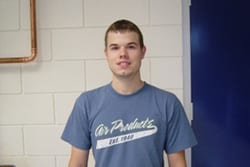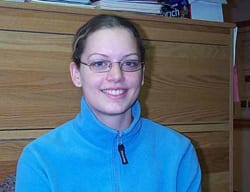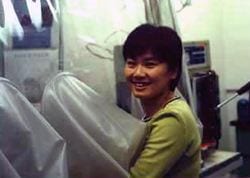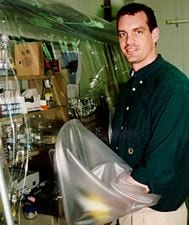PhD Students

Nicholas Cross |
Mohamm ad (Mim) Rahimi PhD 2017. “Thermally regenerative ammonia batteries for converting low-grade waste heat to electricity”. His website is: www.rahimi.us [PhD in Chemical Engineering] ad (Mim) Rahimi PhD 2017. “Thermally regenerative ammonia batteries for converting low-grade waste heat to electricity”. His website is: www.rahimi.us [PhD in Chemical Engineering] |
Yaoli Ye PhD 2017. “The effect of buffer charge and buffer retention on bioelectrochemical systems and post-treatment for microbial fuel cell effluent with fluidized membrane bioreactors.”
Wulin Yang PhD 2016. “Development and optimization of activated carbon air cathode towards scale up applications of microbial fuel cells.” Currently a postdoc at Penn State. [Wulin Google scholar]
Marta Hatzell PhD 2014. “Energy generation from natural and synthetic salinity gradients through reverse electrodialysis and capacitive mixing. (NSF Fellow, 2011-2014). Now on the faculty at Georgia Institute of Technology. [Marta Google scholar]
Matthew Yates PhD 2014. “Sustainable resource recovery and energy conversion processes using microbial electrochemical technologies.”
Lijiao Ren PhD 2014. “Examination of bioelectrochemical systems with different configurations for wastewater treatment. ”
Roland Cusick PhD 2013. “Nutrient and heat recovery from waste streams using microbial electrochemical technologies. (Received an Alumni Association Dissertation Award, 2013, from Penn State University).
Valerie Watson PhD 2013. “Characterization and performance of activated carbon catalysts and polymer membrane layers for microbial fuel cell cathodes and an analysis of power overshoot. (NSF Fellow, 2008-11).”
Fang Zhang PhD 2012. “Development of novel cathode materials and optimization of electrode performance towards scaling-up applications of microbial fuel cells.
Rachel Wagner PhD 2012. “Methane production and methanogenic communities in microbial electrolysis cells, anodic potential influence on microbial fuel cells, and a method to entrap microbes on an electrode. (NSF Fellow, 2007-10).”
Douglas Call PhD 2011. “Development of a scalable microbial electrolysis cell and investigations of exoelectrogenic pure and mixed communities. (NSF Fellow, 2008-11). (Received an Alumni Association Dissertation Award, 2011, from Penn State University).
Priscilla Selembo PhD 2009. “Microbial electrolysis cells: Hydrogen production from glycerol and alternative cathode materials. (co-advised; Chemical Engineering).”
Farzaneh Rezaei PhD 2008. “Electricity from biomass using microbial fuel cells. (co-advised; Ag&Biosystems Engineering).”
Yi Zuo PhD 2008. “Novel electrochemical material applications and exoelectrogenic bacteria isolation from microbial fuel cells (MFCs). (Received an Alumni Association Dissertation Award, 2008, from Penn State University).”
Jung-Rae Kim PhD 2006. “Development of microbial fuel cells (MFCs) using efficient acclimation and various substrates.”
Booki Min PhD 2005. “Perchlorate remediation using packed-bed bioreactors and electricity generation in microbial fuel cells (MFCs).”
Michael Salerno PhD 2005. “Development of microbial fuel cells (MFCs) using efficient acclimation and various substrates.”
Stephen Van Ginkel PhD 2005. “Optimization of hydrogen production from food processing wastewaters.”
Husen Zhang PhD 2005. “Analysis of microbial communities and design of bioreactors used for perchlorate remediation and biohydrogen production.”
Yanguang Song PhD 2004. “Analysis of respiratory enzymes used by perchlorate-respiring bacteria.”
Terri Camesano PhD 2000. “An investigation of bacterial interaction forces and bacterial adhesion to porous media.” [Google citations]
Xiaoyan Li PhD 1996. “Coagulation between fractal aggregates and small particles and fractal properties of marine particles. (Received the Parsons Engineering Science/AEEP 1997 Outstanding Doctoral Dissertation Award.)” [Photo from his Google citations page]
David Confer PhD 1996000. “Degradation of model macromolecules (proteins and polysaccharides) in wastewaters.”
David Jewett PhD 1995. “Bacterial transport in variably saturated porous media.”
Qing Jiang PhD 1992. “Fractal structure of aggregates induced by shear motion.”
Bruce Alleman PhD 1995. “Degradation of pentachlorophenol by selected species of white rot fungi.” [Internet photo ca. 2006]
MS Students

Evan Newcomer |
 Jia Fu MEng in Chemical Engineering (Fall 2022) “Scaling up microbial electrolysis cells” Jia Fu MEng in Chemical Engineering (Fall 2022) “Scaling up microbial electrolysis cells” |
 Anna Iacovino, MEng in Chemical Engineering (Summer 2021) “Inhibiting the chlorine evolution reaction via MnOx overlayer on Ir/Ti electrodes”. Anna Iacovino, MEng in Chemical Engineering (Summer 2021) “Inhibiting the chlorine evolution reaction via MnOx overlayer on Ir/Ti electrodes”. |

Emmanuel Fonseca MS (2020) “Improving microbial electrolysis stability using flow-through brush electrodes and monitoring anode potentials relative to theoretical minima.”

Kathryn Lawson MS (2020) “Cathode/catholyte impacts on power density and anode performance in microbial fuel cells”.
Benjamin Cario MS (2019) “Evaluating the impact of substrate composition, reactor configuration, and operating conditions on the performance of bioelectrochemical systems treating fermentation effluents”.
Emily Zikmund MS (2017). “Anode and electrolyte selection to improve hydrogen recovery in microbial electrolysis cells.”
Nicole LaBarge (Galambos) MS (2016) “Effects of acclimation methods on anaerobic fluidized bed membrane bioreactors and methanogenic microbial electrolysis cells.”
Jennifer Stager MS (2015). “Impact of anode-separator configurations and cathode materials on microbial fuel cell performance.”
Maxwell Wallack MS (2015) “Reducing nitrogen crossover in microbial reverse electrodialysis fuel cells by using ion exchange resin.”
Mark Ullery MS (2014). “Screening and acclimation methods for accomplishing treatment and energy recovery from wastewater in microbial electrolysis cells.”
Daniel Hoskins MS (2014) “Salinity effects on polyvinyl alcohol separators and the use of spray-on separarators in air-cathode microbial fuel cells.”
Vanessa Lanas MS (2013). “Examination of brush anode sizes and packing densities on microbial fuel cell performance.”
Robert Davis MS (2013) “Increasing desalination by mitigating anolyte pH imbalance using catholyte effluent addition in a multi-anode, bench-scale microbial desalination cell.”
Zehra Zaybak MS (2012). “Start-up methods for the development of carbon dioxide fixing and biofuel producing biocathodes in bioelectrochemical systems.”
Bin Wei MS (2012). “Electrochemical studies of separators and activated carbon cathodes in single chamber, air-cathode microbial fuel cells.”
Sarah Hayes MS (2011). “Performance of membrane and electrode assembly microbial fuel cells using activated carbon cathodes with various diffusion layers.”
Adam Hutinson MS (2011). “Effect of carbon fiber brush anode surface area on single chamber MFC start up time and internal resistance.”
Matthew Yates MS (2011) “Bacteria in MFC’s.” (NSF Fellow 2010-2013).”Convergent development of microbial communities in microbial fuel cells.”
Jack Ambler MS (2010). “Redox conditions in MFC’s. Stainless steel 304 and biocarbonate buffer performance in a microbial electrolysis cell using a new method for gas characterization.”
Roland Cusick MS (2010) “A comparison of energy recovered from MFC’s and MEC’s fed winery and domestic wastewater and the performance of a pilot-scale continuous flow MEC fed winery wastewater.”
Geoffrey Rader MS (2010). “Effect of long-term operation on MFC performance and the performance of a scale-up continuous flow MEC with an examination of methods to decrease CH4 production.”
Fang Zhang MS (2010) “Novel cathode materials for microbial fuel cells.”
Yimin Zhang MS (2010). “The use and optimization of stainless steel mesh cathodes in microbial electrolysis cells.”
Charles Winslow MS (2009) “Bacterial adhesions to metal oxide surfaces in the presence of natural organic matter.”
Valerie Watson MS (2009). “Shewanella oneidensis MR-1 compared to mixed cultures for electricity production in four different microbial fuel cell configurations.”
Douglas Call MS (2008) “Hydrogen production in a microbial electrolysis cell lacking a membrane” (Received the Montgomery-Watson-Harza Consulting Engineers/AEESP Masters Thesis Award, First Place, 2009)
Elodie Lalaurette MS (2008). “Hydrogen production from cellulose fermentation end products using microbial electrolysis cell.”
Jenna Heilmann MS (2005) “Proteinaceous substrates and hydrogen production using domestic wastewater.”
Jill Pouliott MS (2005). “Using colloid force microscopy to understand bacterial adhesion.”
Ekatarina Paramonova MS (2005) “Measurement and analysis of bacterial removal by granular activated carbon.”
Yunchul Cho MS (2003). “Using atomic force microscopy to understand the role of polysaccharides in bacterial adhesion”
Xu Li MS (2003) “Bacterial adhesion measured using colloid probe AFM.”
Lisa Steinberg MS (2003) “Enzymes used by (per)chlorate respiring bacteria.”
Shaun Pardi MS (2002). “Investigation of bacterial extracellular polymeric substances utilizing an atomic force microscope with newly developed deflection curve acquisition and analysis protocol”
Booki Min MS (2001) “HBOD measurements using a new HBOD probe.”
Dina LaPoint MS (2000). “Factors affecting perchlorate removal rates in autotrophic packed bed reactors.”
Husen Zhang MS (2000) “Pure culture kinetics and cell yields of (per)chlorate reducing bacteria.”
Karl Shellenberger MS (2000). “The effect of surface roughness and charge heterogeneity on bacterial adhesion.”
Jun Wu (2000). “The abundance and growth of (per)chlorate reducing bacteria using different substrates.”
Kijung Kim (1999). Microbial treatment of perchlorate-contaminated water.”
Amanda DeSantis (1999). An investigation of the effect of motility and cell concentration on the migration of bacteria through porous media.
Joel Miller (1999). “Bioreduction of perchlorate under hydrogen-oxidizing conditions. ”
Peter Mulvaney (1999). Perchlorate and chlorate reduction by axenic cultures (Primary Advisor: Unz)
Kenny Unice (1998). “Quantifying and evaluating dispersion in bacterial transport through porous media.”
Shari Olsen (1997). “Consortium and pure culture kinetics of chlorate reducing microorganisms.”
Terri Camesano (1997). “Enhancing bacterial transport in porous media by manipulation of flow velocity, cell concentration and solution ionic strength.”
Brock Rogers (1997). Bacterial transport through NAPL-contaminated porous media.
Greg Haldane (1996). The biodegradation of large and small molecular weight carbohydrates.
Gretchen Wagenseller (1996). “Molecular size distributions of soluble biochemical oxygen demand and dissolved organic carbon in in trickling filter wastewaters.”
Adam Bliven (1996). “Chlorate respiring bacteria: isolation, identification, and effects on environmentally significant substrates.”
Rabi Patnaik (1996). “Oxygen demand tests and mixed-culture bioreactor studies using chlorate (ClO3–) as an electron acceptor.”
Qun Li (1996). Effects of surfactants, soil types and microbial strains on bacterial transport.
Clifford Johnson (1995). “Settling velocities of fractal aggregates.”
Michael Martin (1995). Using a single diameter to represent grain size distributions for modeling bacterial transport in porous media.”
Brian S. Aiken (1994). The effect of ammonium lignosulphonates on growth, lignin peroxidase enzyme expression, and PCP degradation by white rot fungi
Robert C. Fleury. (1994). “Thymidine and leucine incorporation as indicators of bacterial activity and the kinetics of glucose uptake.”
Karen Blue (1994). Modeling the effects of slow desorption on bacterial transport in porous media.
Mark Gross (1993). “Effects of selected chemical treatments on bacterial transport through porous media.”
John Kilps (1992). “Fractal aggregates generated in different fluid mechanical environments.”
Thomas Hilbert (1992). “Screening bacteria for adhesion in porous media.”
Catherine Vogel (1991). Biodegradation of aromatic compounds in the presence of secondary substrates.
David R. Confer (1991). “Effect of fluid shear on biodegradation of macromolecules.”
Daniel Wilkinson (1989). “Fractal nature of biological aggregates.”
Stanley Miller (1988). “Mass separation techniques for the design of fixed film bioreactors.”
David Phillips (1988). Acclimation of mixed cultures for phenol biodegradation.”
Undergraduate Students (since 1997)

Xinran (Ariel) Zhang |

Joseph Nicolas, 2o21. Major: Chemical Engineering. Joseph’s research including work with microbial electrolysis cells |
 Gihoon Hyung, 2021. Major: Chemical Engineering. He worked on impact of sulfides on anaerobic digestion. |
|
 Benjamin Aronson, 2019. Major: Chemical Engineering at Penn State, working on BDI for ammonia recovery. |
 Elizabeth (Ellie) Alberti, Spring 2019. Major: Chemical Engineering at Penn State. |
 Kelly Kowalski, 2016 |
 Zach Schoener, 2015 |
 Sumit Pareek, 2015 |
 Scott Berman, 2014 |
 Danielle Stenko, 2014 |
 David Slotcavage, 2010 |
 Sikandar Porter-Gill, 2010 |
 Tim Roberts, 2009 |
 Erick Zeikle, 2007 |
 Harrison Zeff, 2007-2008 |
 Jeff Carey, 2006 |
 Aaron Redding, 2006 Aaron Redding, 2006 |
 Garett Estadt,2005-2006 Garett Estadt,2005-2006 |
 Joshua Middaugh, 2005-2006 Joshua Middaugh, 2005-2006 |
 Erica Zerfoss, 2004-2005 Erica Zerfoss, 2004-2005 |
 Courtney Calhoun,2003 Courtney Calhoun,2003 |
 Megan Hamilton, 2003 |
 Katherine Houeruf, 2003 Katherine Houeruf, 2003 |
 David Salabsky,2002 David Salabsky,2002 |
 Ben Lindenmuth,2002 |
 Ekatarina Watson,2002 Ekatarina Watson,2002 |
 Amy Kuhn,2002 Amy Kuhn,2002 |
 Jason Imes, 2002 Jason Imes, 2002 |
 Elizabeth Marcantonio, 2000 |
 Shannon Gority, 2000 |
 Adrienne Elki, 2000 |
 David Kohler, 2000 David Kohler, 2000 |
 Angela Bagley, 1999 |
 Neal Uspal, 1999 |
 Katherine Becker, 1998 |






























































